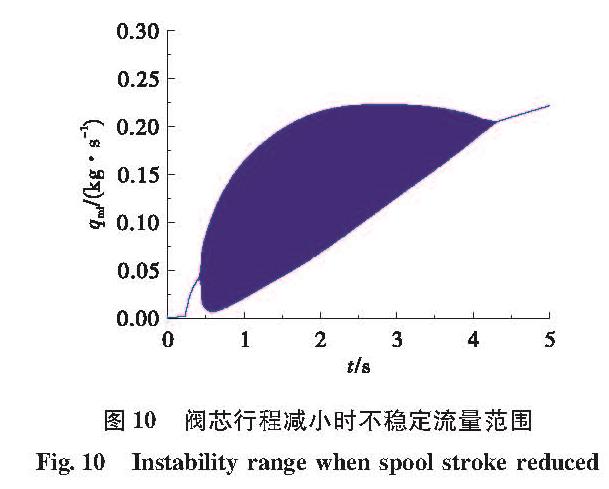作者简介:陈一丹(1997—),男,硕士,研究领域为液体火箭发动机系统仿真。
(西安航天动力研究所 液体火箭发动机技术重点实验室,陕西 西安 710100)
(Science and Technology on Liquid Rocket Engine Laboratory,Xi'an Aerospace Propulsion Institute,Xi'an 710100,China)
liquid propellant rocket engine; check valve; self-oscillation; numerical simulation; experiment validation; Modelica
备注
作者简介:陈一丹(1997—),男,硕士,研究领域为液体火箭发动机系统仿真。
针对液氧煤油发动机系统中液氧单向阀流路在某次试车中出现的振动问题,建立了单向阀流路工作过程的数学模型,提出了求解推进剂管路瞬变流控制方程的Fourier谱方法; 基于新的面向对象Modelica语言,搭建起了液氧单向阀流路瞬态特性研究的模块化仿真模型,并进行了仿真计算。通过对阀前压力添加阶跃扰动的方法实现液氧单向阀阀芯打开过程持续自激振荡。借助仿真计算的方法,分析了造成单向阀自激振荡的原因,阐明了不同流体介质和各设计参数对单向阀工作稳定性的影响。结果 表明:液氧路单向阀自激振荡时,阀前压力和流量均出现持续振荡,且振荡频率约为725 Hz。单向阀自激振荡过程是由瞬态液动力和弹簧弹力耦合作用主导。减小工质密度、减小节流孔直径、减小阀芯行程和调整阀前后节流孔压降都有助于抑制阀芯的振动。
The transient model of check valve flow-path system used in a staged combustion cycle LOX/kerosene engine system was established. The partial differential equations governing the unsteady flow of propellant pipelines were solved by the Fourier spectral method. A modularization model of a characteristic research system for check valve flow-path system was established based on Modelica language. The continuous self-excited oscillation of the open process of the liquid oxygen check valve core was realized by adding step disturbance to the pressure in front of the valve. Then aiming at the instabilities observed during testing operation,the influences of several structural and control parameter on the stability of check valve were clarified by a series of simulation. The results show that during the self-excited oscillation of the liquid oxygen check valve,the pressure and flow rate in front of the valve oscillate continuously,and the oscillation frequency is close to about 725 Hz. The process of self-excited oscillation of check valve may be dominated by transient hydrodynamic and spring elastic coupling. Those measures which can improve the dynamic stability include:increasing the mass of valve spool,reducing the size of orifice,increasing the stiffness of diaphragm. The comparison with the experimental results confirms the effectiveness and feasibility of some measures.
引言
在液氧煤油发动机的研制过程中,由于燃气发生器液氧流路流量要求值减小,当流量小于该流路中单向阀最初设计流量时,阀芯没有达到全开状态,单向阀中“阀芯-弹簧”会形成一个低阻尼的振荡系统。在整机热试车过程中,单向阀阀芯出现持续颤振,进而在液氧流路系统中产生激励源,引起燃气发生器供应系统的耦合振荡,并大幅增加发动机结构振动,最终导致试车提前停止。为了研究液氧单向阀流路系统的自激振荡特性,试车后设计了对应的液流模拟试验。在一定的条件下,复现了单向阀颤振的现象。
文献[1]针对该系统在液流试验中出现的自激振荡现象,在建立单向阀流路系统动力学模型的基础上,利用数值仿真和非线性动力学理论,计算分析了单向阀流路系统产生自激振荡的特点和条件。文献[2]采用AMESim软件改进前后单向阀特性进行了仿真分析和试验验证。上述文献为液氧煤油发动机蒸发器液氧路单向阀改进设计和优化提供一定的指导作用。不足之处是未能定量确定该系统的不稳定域以及各设计参数对不稳定域的影响,深入分析液氧单向阀流路系统的不稳定机理。目前,对单向阀自激振荡特性仿真分析主要采用两种方法:一是建立单向阀动态仿真模型,结合试验数据分析单向阀产生振荡的原因,分析各因素对单向稳定性的影响[1-4]; 另一种是采用三维动态流场仿真的方法,通过数值仿真,分析不同因素对单向阀动态稳定特性的影响[5-6]。
本文通过对液氧单向阀流路系统建立非线性时域模型,采用数值仿真方法,找出阀芯的振荡原因,进一步确定单向阀的不稳定域及其影响因素。
1 系统仿真模型
2 仿真计算及结果分析
2.1 某次液流试验状态仿真根据液氧单向阀流路系统,基于Modelica语言[20]开发了相应组件模型库[21],并搭建了液氧单向阀流路系统仿真模型,如图3所示。
对某次液流试验进行了仿真模拟,入口压力13.0 MPa、出口压力1.8 MPa,对应水流量0.11 kg/s情况下,单向阀最初是稳定的,但当0.5 s时,入口压力加载一个0.05 MPa的阶跃信号时液氧单向阀出现明显颤振,频率为725 Hz,且振动幅值逐步增大,到0.58 s后,振动幅值趋于稳定,并一直维持下去。此时,阀芯已无法达到全开状态,在0.26 mm 左右颤振,如图4所示。单向阀流路系统中流量和压力也随之出现波动,如图5和图6所示。
图5和图6中qmi、pi、qme和 pe分别表示单向阀入口的流量及压力和出口流量及压力; qmm表示阀芯节流孔流量。由于阀门入口至阀芯距离远小于流路压力波波长,故实际计算时方程(1)中p1取阀门入口压力pi。0.5 s前,阀芯受力平衡,开度保持不变。阶跃信号加载后,首先导致p1增加,阀芯向开度增加的方向移动和阀门流量增加,进而导致稳态液动力和瞬态液动力增加,且瞬态液动力方向为阀门打开方向,阀门逐渐向新的平衡位置靠近。但临近该位置时流量变化逐渐平缓,瞬态液动力急剧减小。此时由p1增加而产生的额外压力和流量增大产生的额外稳态液动力小于弹簧弹力增加的部分,阀芯打开速度减缓直至为0 m/s,此刻,瞬态液动力为0 N,流量达到峰值,阀芯合力方向为关闭方向。故下一时刻阀芯向关闭方向运动,流量逐渐减小,稳态液动力和弹簧弹力都减小,此时瞬态液动力再次出现且方向为阀门关闭方向,故阀门关闭的加速度增大,直至靠近开度最小值,瞬态液动力再次急剧减小。此时由p1增加而产生的额外压力足以弥补流量减少导致的稳态液动力减小,且开度减小导致弹簧弹力降低,阀芯关闭速度减缓直至为0 m/s,此刻,瞬态液动力再次为0 N,流量达到谷值,阀芯合力方向为打开方向,后续阀芯的运动情况则是重复上述过程。故而在经历一个约为0.08 s的发展阶段后于0.58 s形成阀芯稳定振动。
自振系统是由能源、振动体、调节输出振动体能量的控制体和给控制体传递振动反馈机制作用的通道构成的能够产生等幅振动的振动力学系统[22]。在单向阀系统中,阀芯的振动会改变其周围的流场,流场的改变则会影响阀芯的受力。而瞬态液动力的作用效果是一种负的阻尼项,在上述过程中充当反馈机制,调节系统的能量输入使其维持稳定的振动。结合具体过程来看,阀门开度达到峰值时瞬态液动力消失,而在后续阀门关闭过程促进阀门更快地关闭; 当阀门开度跌落谷值时,瞬态液动力再次消失,并在后续阀门打开过程促使其更快打开。弹簧作为储能元件,其充能和释能过程皆是由瞬态液动力和弹簧弹力耦合作用控制。其余作用力则是作为能源输入项或能量耗散项并与振动体(阀芯)和该反馈机制共同构成单向阀自振系统。故该自振过程是由瞬态液动力和弹簧弹力耦合作用主导。
2.2 逐步增大入口压力时的仿真结果在仿真过程,令初始入口压力p1和出口压力p2相同(同为1.8 MPa),并逐步增大系统入口压力(最大值为40 MPa),观测使液氧单向阀处于颤振状态时的流量范围。
由图7可以看出,当流量在0.06~0.14 kg/s范围内时,对应的入口压力范围是6.56~17.57 MPa,单向阀出现明显的颤振,当流量为0.06 kg/s时,频率为769 Hz,流量0.11 kg/s时为725 Hz,0.16 kg/s时为737 Hz。
入口压力小于6.56 MPa时,压力的增加同样会导致阀门开度增大和流量增大,此时由于阀门开度小即弹簧弹力小,流量基数小但变化快,瞬态液动力和稳态液动力以及压力等合力大于弹簧弹力,阀门开度会继续增大; 当入口压力大于17.57 MPa,虽然瞬态液动力降低,但是阀芯受到压力合力足够大,能够克服弹簧弹力使阀芯持续向打开方向运动。对于频率而言,流量增大,从而液动力项在阀芯的当量质量中所占比例增大,引起阀门结构固有频率降低。
2.3 流体介质为液氧时的不稳定范围当流体介质为液氧时,同样以2.2小节中的方法,逐步增大入口压力p1,以提高流经单向阀流量,旨在确定流体介质为液氧时的不稳定流量范围,仿真结果如图8所示。
由图8可以看出,当流量在0.04~0.21 kg/s范围内时,对应的入口压力范围是5.01~34.82 MPa,单向阀出现明显的颤振,当流量为0.04 kg/s时频率为791 Hz、流量为0.18 kg/s时频率为729 Hz、流量为0.21 kg/s时频率为693 Hz。
由于液氧的密度(-183 ℃时1.143×103 kg/m3)比水的密度(4 ℃时1.0×103 kg/m3)大,在相同的压差和阀门开度下,液氧的质量流量更大,这意味着入口压力较小的情况下阀芯就会受到较大的稳态液动力,进入自振状态所需要的瞬态液动力更小,进而导致自振过程的振幅增加和开始压力降低,故而5.01 MPa下开始自振。同时密度的增加就意味着相同质量流量变化率下的瞬态液动力更大,需要更大的入口压力才能克服弹簧弹力使阀门持续打开,故大约于34.82 MPa结束自振。所以增加介质密度不利于抑制自振。
2.4 改变阀芯节流孔径对不稳定域的影响将单向阀阀芯节流孔径由3 mm减小至1.5 mm的仿真结果如图9所示。
减小节流孔的情况下,为了达到和之前同样的流量,需要p1的压力值更大。相同条件下流量和流量的变化都减小,故减小节流孔实际上是减小稳态液动力和瞬态液动力,进而在较小的压力下受力已经达到平衡,后续在压力的作用下阀芯持续打开。事实上,从式(4)中不难看出,瞬态液动力在阀芯动力学表达式中是一种高阶项,减小阀芯节流孔增加了单向阀的流阻,一定程度能够抑制高阶波动。故减小阀芯节流孔直径有利于抑制单向阀自振。
2.5 减小阀芯行程对不稳定域的影响在2.3节的基础上将阀芯行程由3 mm改为1.5 mm会产生以下两方面影响:一是阀芯最大开度时所受到的弹簧弹力减小,这意味着达到最大开度所需要的入口压力降低; 二是在其他条件相同时,阀门最大开度下的流量更少,稳态液动力也就更小。
减小阀芯行程时的仿真结果如图 10所示。随着入口压力的不断增加,开始自振的入口压力应当相同; 由于在建模时不考虑阀芯与阀座碰撞的回弹问题,认为阀芯与阀座接触时速度突变为0 m/s,为了避免数值问题,会将碰撞时瞬态液动力赋值为0 N。通过对比图 10和图8的结果发现,两次仿真结果相同,即减少阀芯行程没有改变自振的振幅或者频率或者不稳定域,同时阀芯没有出现与阀座撞击的情形。故一定程度减小阀芯行程对单向阀自振无影响。
3 结论
为获得液氧路单向阀自激振荡特性,通过增加阀前压力阶跃扰动的方式,使阀门开启过程中阀芯出现持续的自激振荡,并通过改变流动介质和阀门设计参数探究其影响因素。本文研究表明:
1)液氧路单向阀自激振荡时,阀前压力和流量均出现持续振荡,且振荡频率接近。
2)单向阀自激振荡过程是由瞬态液动力和弹簧弹力耦合作用主导。
3)减小工质密度、减小节流孔直径、调整阀前后节流孔压降都有助于抑制阀芯的振动; 一定程度地减小阀芯行程对自振无影响。
液氧单向阀流路系统由单向阀前孔板、液氧单向阀、单向阀后孔板、液氧主导管、产品管路等组成,如图1所示。系统仿真模型是由系统原理图搭建而成,包括分布参数的管路模型、单向阀模型和节流孔板模型等。
1.1 单向阀模型单向阀的动力学模型是在分析阀芯受力和运动的基础上建立的,阀芯运动方程为
m(dv)/(dt)=p1A1+p2(A3-A1)-p3A3-
F0-Kx-Ffv-Ffsign(v)-Fs-Fi(1)
(dx)/(dt)=v(2)
式中:x、v、m 分别为阀芯开度、阀芯运动速度、阀芯和弹簧的折算质量; F0、K 分别为弹簧预紧力和弹簧刚度; A1、A3和p1、p3分别为阀芯前和后压力作用面积和作用压力; p2为中间腔压力; Ff 为阀芯导向面间隙黏性摩擦力系数,按层流黏性力计算时Ff 为干摩擦力; Fs、Fi分别为稳态和瞬态液动力。
1.1.1 稳态液动力稳态液动力是在流场为定常流情况下,仅由于流体在流道中速度不同而引起的力,其作用方向与阀芯关闭方向一致,对阀门起稳定作用。作用在阀芯上的稳态液动力可以由动量定理求得
Fs=(1/ρA1)m·21(3)
式中m·1为阀芯阀座节流口处的流量。
1.1.2 瞬态液动力瞬态液动力是流场为非定常流情况下,由流速变化引起的力。这是一种阻尼力,有正、负之分。当流体流动方向与阀芯打开方向一致时,阻尼力为正值; 反之,为负值。可表示为
Fi=-L(dm·1)/(dt)(4)
式中L为液动力阻尼长度,取阀座入口中心线与节流隙缝中心线之间的距离[7]。
单向阀结构与部分受力如图2所示。
1.1.3 中间腔压力在考虑流体的压缩性时,中间腔压力变化规律为
(V/a2)(dp2/dt)=m·1-m·2(5)
式中:V为中间腔容积; a为流体音速; m·2为流经阀芯小孔的质量流量。
1.2 管路模型及其数值求解在液氧单向阀流路系统中,管路波动影响较显著,且频率较高,所以管路模型采用分布参数模型,具体形式如下[3]
(∂p)/(∂t)+ρa2(∂u)/(∂x)=0,x∈[0,L](6)
1/ρ(∂p)/(∂x)+(∂u)/(∂t)+f/(2D)u|u|=0,x∈[0,L](7)
式中:p为x断面的流体平均压力; u为x断面的流体平均体积流量; ρ为流体密度; a为压力波传播速度; f为管壁摩擦损失系数。
液氧管路瞬变流基本微分方程(6)与方程(7)是一对拟线性双曲型偏微分方程组,在液体推进剂管路瞬变流方程的数值求解方面,特征线方法(MOC)和分段集中参数有限单元法(FEM)是目前最常用的液体管路方法[8-15]。本文所研究的液氧单向阀流路自激振荡特性具有周期性,因此本文选用周期函数Fourier级数作为基函数,将管路内流体未知量分解展开成空间变量基与时间函数系数的分离变量形式的解式[16-17]。瞬变流基本微分方程(6)与方程(7)的求解域为[0,L],采用Fourier级数为基函数的谱逼近方法求解该方程组时,Fourier级数的定义域为[-1,1],先对方程(6)与方程(7)进行坐标变换[18-19],令y=2x/L-1,则求解域变换为y∈[-1,1],并令
τ=(ta)/L,φ=p/(p0),U=u/a,ε=(p0)/(ρa2),μ=(fL)/(2D)
可得无量纲管路瞬变流方程
(∂φ)/(∂τ)+2/ε(∂U)/(∂y)=0,y∈[-1,1](8)
(∂U)/(∂τ)+2ε(∂φ)/(∂y)+μU|U|=0,y∈[-1,1](9)
式中p0为管道内液体初始压力。对无量纲压力φ(y,τ)作Fourier正弦级数展开
φ(y,τ)≈φ(0,τ)+y[φ(1,τ)-φ(0,τ)]+
2∑Nk=1[((-1)kφ(1,τ)-φ(0,τ))/(kπ)+φk(τ)]sin(kπy)(10)
流速U(y,τ)作Fourier余弦级数展开
U(y,τ)≈U0(τ)+2∑Nk=1Uk(τ)cos(kπy)(11)
式(10)是通过φy(y,τ)的Fourier余弦级数展开,然后逐项积分所得。Fourier展开式中时间相关系数φk(τ)和Uk(τ)为
φk(τ)=∫10φ(y,τ)sin(kπy)dy(12)
Uk(τ)=∫10U(y,τ)cos(kπy)dy(13)
式中k∈{1,2,…,N}。将无量纲液体压力φ(y,τ)、流速U(y,τ)的Fourier谱展开式(10)和式(11)代入式(8)和式(9)中,得
(dφk(τ))/(dτ)=(kπ)/εUk(τ)(14)
(dUk(τ))/(dτ)=-kπεφk(τ)+
ε[φ(0,τ)-(-1)kφ(1,τ)]-
∫10μcos(kπy)U(y,τ)|U(y,τ)|dy(15)
式中非线性摩擦积分项采用离散Fourier变换,具体参见文献[17]。这样,液氧管路瞬变流偏微分方程(8)和方程(9)的求解问题就转换为确定系数函数φk(τ)和Uk(τ)的常微分方程求解问题。
- [1] 刘上,刘红军,徐浩海,等.单向阀流路系统自激振荡特性研究[J].火箭推进,2011,37(3):1-5.LIU S,LIU H J,XU H H,et al.Research of self-oscillation characteristics of check valve flow-path system[J].Journal of Rocket Propulsion,2011,37(3):1-5.
- [2] 雷恒,贾景卫,谢宁.液氧煤油发动机蒸发器路单向阀结构优化[J].火箭推进,2012,38(1):27-30.LEI H,JIA J W,XIE N.Structure optimization of check valve in evaporator pipeline of LOX/kerosene engine[J].Journal of Rocket Propulsion,2012,38(1):27-30.
- [3] 陶柳,王云,雷雄.基于AMESim的单向阀仿真研究分析[J].装备制造技术,2016(2):72-75.
- [4] 史刚,岳兵,尹文辉,等.运载火箭气体单向阀防颤振技术研究[J].制造技术研究,2016(2):30-33.
- [5] 余武江,王海洲,陈二锋,等.单向阀三维动态流场稳定性仿真研究[J].火箭推进,2015,41(1):82-89.YU W J,WANG H Z,CHEN E F,et al.Research on three-dimensional dynamic flow stability of check valve[J].Journal of Rocket Propulsion,2015,41(1):82-89.
- [6] 杨国来,靳松,刘圆圆,等.液控单向阀的气穴旋涡现象和流量分析[J].液压气动与密封,2019,39(2):1-4.
- [7] 蔡亦纲.流体传输管道动力学[M].杭州:浙江大学出版社,1990.
- [8] KALIN V M.Peculiarities of start regime organization in stage combustion cycle liquid rocket engine [R].IAF-83-37.
- [9] 程谋森,张育林.推进剂供应管路充填过程研究[J].推进技术,1997,18(2):70-74.
- [10] THOMPSON P F, WALSH T J.Characterization of attitude control propulsion systems[R].NASA-CR-115183,1971.
- [11] MARKOWSKY J J.An analytical model for predicting the pressure and flow transients in a gaseous H2.02100 LBF thrust reaction control system rocket engine [R].N73-16767,1971.
- [12] 王克昌.液体火箭发动机瞬变过程的计算机模拟[J].宇航学报,1981,2(1):31-41.
- [13] 张黎辉,李家文,张雪梅,等.航天器推进系统发动机动态特性研究[J].航空动力学报,2004,19(4):546-549.
- [14] THANAPANDI P,PRASAD R.A quasi-steady performance prediction model for dynamic characteristics of a volute pump[J].Proceedings of the Institution of Mechanical Engineers,Part A:Journal of Power and Energy,1994,208(1):47-58.
- [15] ZUO Z F,MAEKAWA H.Application of a high-resolution compact finite difference method to computational aeroacoustics of compressible flows[C]//Proceedings of ASME-JSME-KSME 2011 Joint Fluids Engineering Conference,July 24-29,2011.Hamamatsu,Japan:[s.n.],2012:3397-3406.
- [16] TADMOR E.Convergence of spectral methods for nonlinear conservation laws[J].SIAM Journal on Numerical Analysis,1989,26(1):30-44.
- [17] 陈宏玉,刘红军,刘上.水击问题的Fourier谱方法计算[J].火箭推进,2012,38(3):7-11.CHEN H Y,LIU H J,LIU S.Spectral-Fourier method for water hammer[J].Journal of Rocket Propulsion,2012,38(3):7-11.
- [18] ZHANG Y L,VAIRAVAMOORTHY K.Transient flow in rapidly filling air-entrapped pipelines with moving boundaries[J].Tsinghua Science & Technology,2006,11(3):313-323.
- [19] ZHANG Y L,VAIRAVAMOORTHY K.Application of method-of-lines to charging-up process in pipelines with entrapped air[J].Tsinghua Science & Technology,2006,11(3):324-331.
- [20] 陈立平,周凡利,丁建完.多领域物理统一建模语言MODELICA与MWORKS系统建模[M].武汉:华中科技大学出版社,2019.
- [21] 陈宏玉,刘红军,陈建华.液氧煤油发动机瞬态特性模块化通用仿真研究[C]//航空宇航科学与技术全国博士生学术论坛.长沙:[s.n.],2013.











